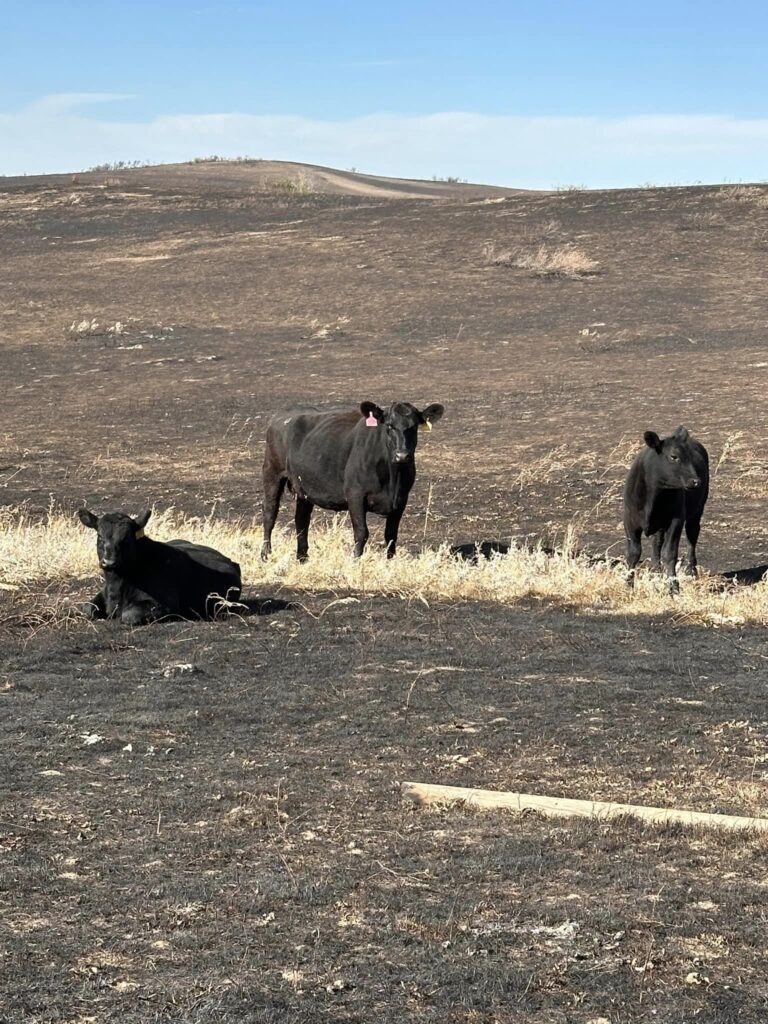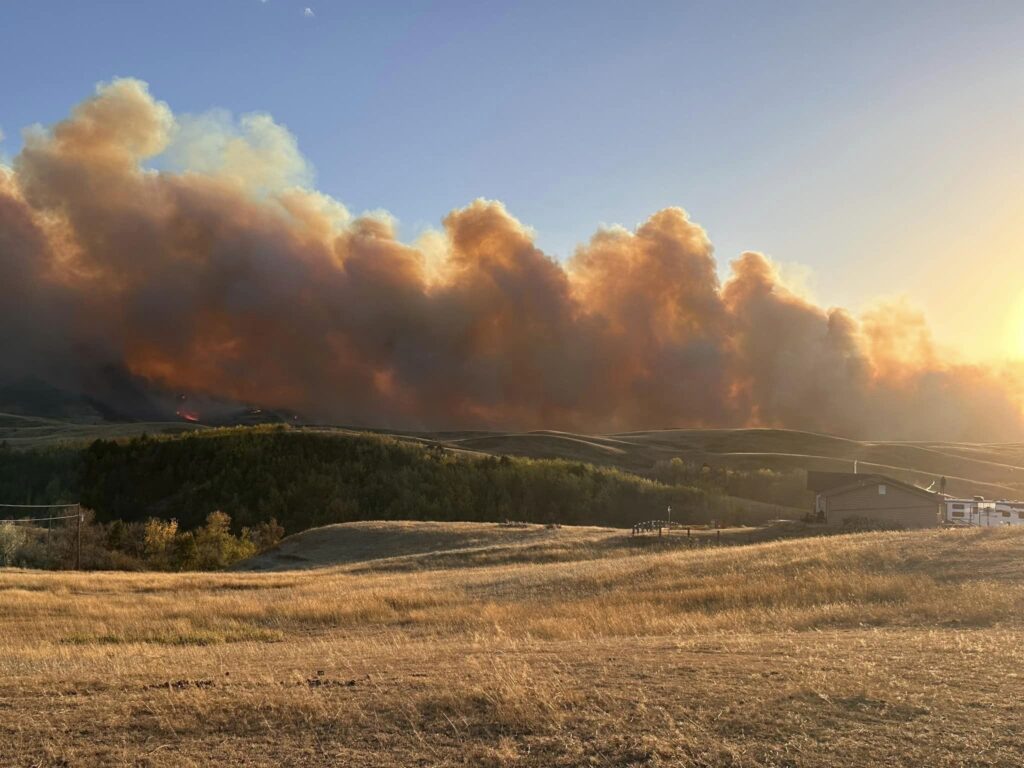UTTC International Powwow attendees share their rules for a fun and considerate event
Weekend wildfire damage approaches 50,000 acres, Burgum says
Michael Achterling and Jeff Beach

North Dakota National Guard soldiers and airmen worked with the Department of Emergency Services to build a handline and conducted a controlled burn to prevent the further spread of a wildfire near Mandaree on Oct. 6, 2024. Gov. Doug Burgum declared a statewide fire emergency and activated the North Dakota National Guard. (U.S. Army National Guard photo by Staff Sgt. Samuel J. Kroll, visual information photographer)
Vawnita Best said it was a battle to bring in cows grazing on federal land back to the ranch near Watford City as strong winds whipped up a grassland fire Saturday.
“You could hardly stay on your horse,” she said.
On Monday, the wind had shifted directions blowing smoke onto the ranch and raising concerns about the health of cattle and horses the ranch relies on.
Best said she knows where most of the cows are, though some ranchers cut fences to let cattle escape flames as best they could.
“Minimal losses compared to many,” she said Monday, still warily keeping an eye on the fire.
Missing cattle, burned up fencing and pasture and hay burning away are some of the dire consequences of a weekend of wildfires in northwest North Dakota.

Gov. Doug Burgum said during a Monday press conference that more than 50,000 acres of farm and ranch land could be affected by the fires when the final totals come in.
Keith Daniel farms near Ray. He doesn’t have livestock but worries about topsoil blowing away in fields where crop stubble burned away.
He said the area is desperate for rain, or even snow.
“Black dirt is going to blow all winter,” he said.
Daniel is a no-till farmer, leaving stubble from harvested crops to help prevent wind erosion, rather than plowing it under. But he keeps a chisel plow on the farm and used it to till up the soil around his farm as a fire break, which was effective.
He said other nearby farms lost everything – barns, houses, equipment.
“There are places that are plumb gone, nothing left,” Daniel said.
He said the area looks like a “war zone” with power poles burned away and fields and pastures scarred by the wildfire.
The fires have claimed at least one life and caused at least one critical injury. At least four residences and numerous outbuildings have been reported destroyed.
Burgum and other state officials toured the fire damage Monday.
“It’s possible that Saturday, when it all comes in, is going to go down as one of the worst combined fire days in the history of North Dakota,” Burgum said during a news conference in Watford City. “It may not be the No. 1 in terms of number of fires … but this could be the most number of acreage.”
The Elkhorn fire in McKenzie County had 20% containment on Monday and is estimated to stretch 12 miles long by five miles wide, according to the McKenzie County Sheriff’s Office.
The Bear Den fire near Mandaree was estimated to be 0% contained as of Monday afternoon, according to the governor’s office. Fires near Arnegard, Emmet, Charlson were reported to be at least 100% contained Monday afternoon while fires in Williams County were 90% contained with active flare-ups.
Ryan Melin, fire management officer for the North Dakota Forest Service, said zero visibility and 70 mph winds made navigating around the frontline challenging.
“When we’re operating in those zero visibility conditions, you can imagine that it’s a pretty eerie feeling as you are trying to do some work at a fairly rapid speed, and not knowing where anyone else is,” Melin said.
He also said there were a lot of smaller fires that were identified during the emergency and commended local firefighters in responding to those blazes in order to keep them small while frontline responders battled the larger fires.

Best credited local volunteer firefighters with keeping the fire near her ranch under control on Friday, but she was grateful for the additional response from state and federal fighters on Saturday.
“Thanks to all of the volunteers and all of the skilled firefighters and hotshots that have been sent up,” she said.
Brig. Gen. Mitchell Johnson, adjutant general of the North Dakota National Guard and director of the Department of Emergency Services said three MH-60 helicopters have been taking water from Lake Sakakawea to dump on fires.
Best said the battle near her ranch was far from over.
“This was not a one-day event,” she said. “This will be a marathon.”
For some ranchers, that includes tracking down their cattle.
The North Dakota Stockmen’s Association has received a handful of missing cattle reports due to the wildfires, said Corby Ward, chief brand inspector for the association.
“I think guys are still out looking and figuring out where their cattle are,” Ward said.
He also said some ranchers who were able to get ahead of the fire may have cut some of the fences to allow the animals to escape the fire.
Ward said drivers will need to remain vigilant near fire-affected areas for cattle that are normally fenced in.
Lost or found cattle can be reported to the North Dakota Stockmen’s Association to cward@ndstockman.org or jellingson@ndstockmen.org or by calling 701-223-2522.
“We can help with as much as we can,” Ward said.

Matt Perdue, government relations director with the North Dakota Farmers Union, the state’s largest farm group, said a fire came within 200 feet of the farm he grew up on near Ray.
With farmers losing pastures, hay, feed and sometimes cattle to the fire, he said there are programs through the U.S. Department of Agriculture that can provide assistance.
The programs include the Livestock Indemnity Program (LIP), Livestock Forage Disaster Program (LFP)and the the program known as ELAP, Emergency Assistance for Livestock, Honey Bees, and Farm-raised Fish.
“There are resources out there,” Perdue said, but added that there are always gaps.
Farm Service Agency State Director Marcy Svenningsen said county offices are ready to assist producers.
The North Dakota Agriculture Department has activated its Hay Hotline for Rancher Relief in response to the fires.
Producers in North Dakota in need of hay and those with hay available can call the hotline number – 701-328-5110 – to coordinate hay distribution.
State Veterinarian Ethan Andress said people should be aware of livestocks issues related to smoke and consult with their veterinarian.
“Cattle impacted by wildfire and smoke are at increased risk of complications such as pneumonia. Moving and handling livestock should be done with caution and patience to minimize stress on these animals,” Andress said in a news release.
North Dakota State University Extension is coordinating with state and federal partners to assess agricultural losses caused by the wildfires.
Once fires are extinguished, the state will assess damage to public and private infrastructure to determine if it meets the threshold for a presidential disaster declaration, according to Burgum’s office.
The Federal Emergency Management Agency on Sunday authorized federal funds to assist firefighting efforts in McKenzie County and on the Fort Berthold Reservation.
External
Three artisans at the UTTC International Powwow in Bismarck share their creative journeys
Radio collaboration highlights importance of cooperation in a season of funding cuts for local media
The ceremony also honored players who have passed
A memorial in the Snow County Prison, now the United Tribes Technical College campus
It’s just as important as preserving Native language and culture, he says






